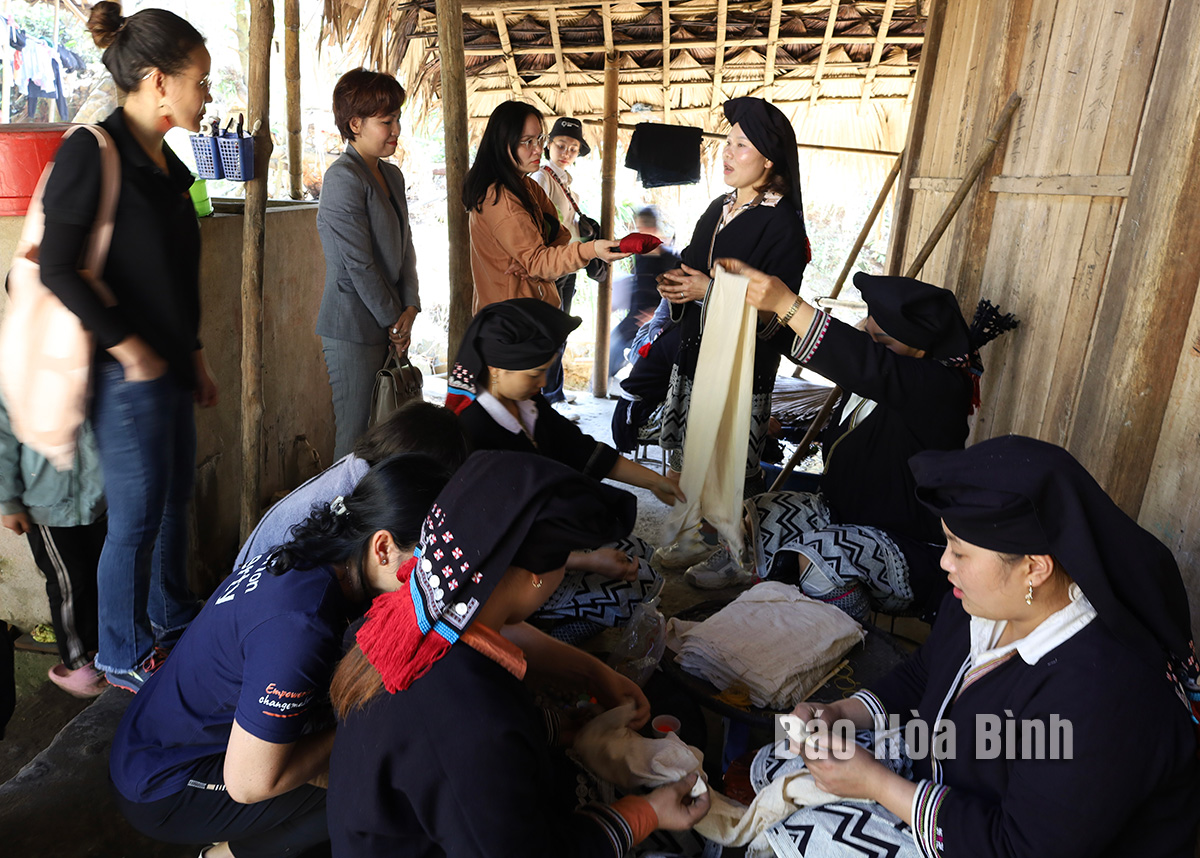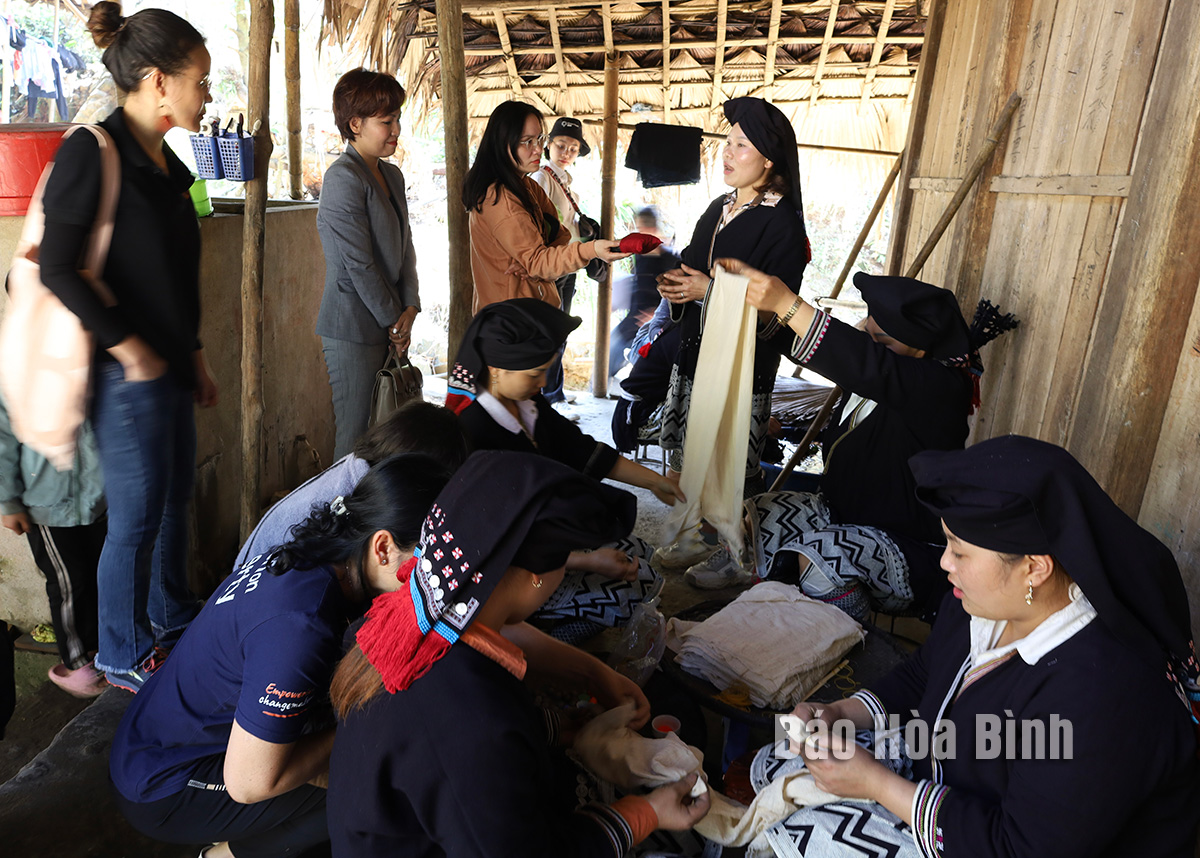
With the diverse cultural identities of the Muong, Tay, Dao, and Thai ethnic groups and endowed with natural beauty, the mountainous district of Da Bac has been gradually developing tourism in association with preserving and promoting traditional cultural values.
In addition to community-based tourism attractions, resorts and
eco-tourism areas have been invested and put into operation in the district,
offering tourist products. Party committees and local authorities pay attention
to annual festival activities such as the Dao people’s New Year festival in Cao
Son commune, the Thac Bo temple festival in Vay Nua commune, the Muong bridge
festival in Muong Chieng commune and many other small festivals to increase
tourism attraction.
Photo: Tourists experience dyeing to create brocade in Sung hamlet, Cao Son
commune, Da Bac district.
According to Nguyen Van Toan, head of the Culture and Information Department of
Da Bac district, local scenic spots are being exploited to serve tourism
development. For example, Thac Bo temple in Vay Nua commune, the place to
worship Dinh Thi Van - a woman who helped people and soldiers transport food
through Thac Bo to Muong Le (in neighbouring Son La province). Visitors to the
temple usually make pilgrimages, pray for fortune and good luck, go
sightseeing, and enjoy the fresh air there.
Meanwhile, when visiting the nearby Coconut island, visitors can
walk around the island, visit orchards, enjoy fruits, sail surrounding the
island, enjoy local specialties and stay overnight in lovely stilt houses.
A scenic spot that is popular with many tourists, especially foreigners, is the
1,580-ha Pu Canh Nature Reserve spaaning the communes of Doan Ket, Yen Hoa,
Dong Ruong and Dong Chum. The reserve boasts rich flora and fauna ecosystems,
waterfalls, streams and primary forests. The Tay and Muong ethnic people live
at the foot of the Pu Canh mountain with various unique cultural features from
costumes, scripts, and cuisine plus gentle and friendly native people, which
are favourable conditions to develop eco-tourism, and experiential and
adventure tourism.
Since 2017, households in villages along Hoa Binh lake have developed
community-based tourism, for example, Sac Luyen, Sanh Thuan, Huu Thao, and Ha
Khanh homestays in Ke hamlet, Hien Luong commune.
Using the homestay service, tourists can experience life with the Muong ethnic
people, and take physical activities such as cycling, swimming, kayaking, and
go fishing.
Several popular resorts in the districts are Mai Da Lodge in Doan Ket hamlet -
Tien Phong commune; Xoan Retreat Da Bac in Mo hamlet, Da Bac Ecolodge in Mai
hamlet, Hien Luong commune; and Ho Tam homestay in Cao Son commune.
In addition, visitors to Da Bac can explore beautiful caves and waterfalls,
such as Lo Lan cave in Hien Luong commune, Ho Vang cave in Nanh Nghe commune,
Sung cave in Cao Son commune, Bong waterfall in Tan Minh commune.
Through communications and promotion programmes by the locality, project
investors and especially the Da Bac Community Tourism joint Stock Company,
local tourism is witnessing significant development. Currently, there are
tourism programmes for tourist groups including a three-day tour to explore the
customs and nature of the Muong ethnic group in Da Bac and Tan Lac; a two-day
tour to explore the customs and nature of the Muong ethnic area in Ke and Da
Bia hamlets; the two-day tour named "Sacred Forest Footprints” to explore the
traditional culture and pristine nature of the Dao Tien people in Sung
hamlet.
Located just a 20-minute drive from Hoa Binh City, Ora Hill Farmstay & Glamping Hoa Binh is a captivating new destination nestled in Mo hamlet, Bình Thanh commune, Cao Phong district. Combining farming with leisure, this tranquil retreat is perfect for those seeking balance, joy, and an immersive experience in the expansive beauty of nature.
Muong Bi - Tan Lac is renowned as one of the four famous Muong regions in Hoa Binh province. Blessed by nature with a favourable climate and stunning landscapes, Tan Lac holds great advantages for tourism development. The local tourism industry has made remarkable strides in recent times thanks to the attention and support from the local authorities and sectors.
With its strategic location, well-developed transport network, and diverse soil and climatic conditions, Hoa Binh is emerging as a must-visit destination in Vietnam's northwestern tourism corridor. The province boasts numerous attractions, including the Kim Boi hot springs (Kim Boi district), the Dau Rong cave complex (Cao Phong), the Mai Chau valley (Mai Chau), and the iconic Hoa Binh hydropower plant.
The northern mountainous province of Hoa Binh has been listed among the 71 most beautiful places to visit worldwide by the prestigious US travel magazine Condé Nast Traveller.
Hoa Binh province’s rich natural and cultural resources position it as a prime location for developing community-based tourism (CBT). In recent years, support from central and provincial policies, as well as assistance from non-governmental organisations, have encouraged local ethnic minority and mountainous communities to actively engage in the sector.



